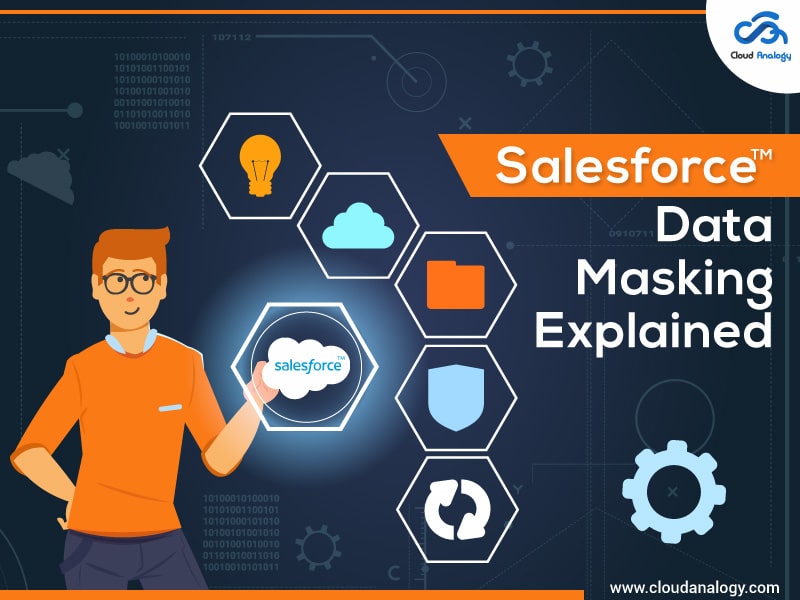Sharing is caring!
With the ubiquitous connectivity heavily across mobile devices, computers, clouds, and applications, there is a growing need for businesses to handle large amounts of data safely. Data security is a big deal for all organizations and hence keeping the data safe should always be a top priority.
Traditional data protection methods such as firewalls, encryption, and passwords often fail to secure the data properly. Today, one of the biggest challenges for companies is to adopt an innovative approach to expose sensitive data only to authorized people while maintaining the highest standards of confidentiality and compliance with regulations.
For this, businesses must go beyond existing methods and move on to comprehensive solutions that provide data protection at a more detailed level. That’s where Data Masking came into the picture to bridge the gap left by the traditional protection methods to data security.
Introduction to Data Masking
Your live production Salesforce Org includes some of the most sensitive and confidential information in your organization. In a production environment, data benefits from strong confidentiality and privacy protection. However, if it gets migrated into a test environment for use by Salesforce developers, administrators, or quality assurance, they might not get the same attention. If no actions are taken to protect this information, your organization may find that it does not comply with industry regulations and is at high risk of data loss during security breaches.
Data Masking is also called data anonymization or pseudonymization. Live Data is immediately anonymized to ensure safe use in non-production environments. Anonymization adds fictitious details to the data to hide sensitive information such as credit card numbers and customer addresses. When security breaches occur and non-production data is compromised, data masking minimizes the risk of disclosure of sensitive and confidential information.
There are many techniques for masking live data. These techniques can be used to rearrange the existing content of information or replace it with user-specified data. These techniques protect the production information without reducing its usefulness.
Four Reasons Why Data Masking is the Best Practice for Salesforce Operations:-
1. Regulatory compliance
Almost all organizations are subject to regulations that stores data. Maintaining compliance often requires compliance with certain data security rules. For example, Payment Card Industry Data Security Standards (PCI), Portability Insurance and Health Insurance Liability (HIPAA), and General Data Protection Regulations (GDPR) include specific guidelines for managing credit card information and medical records as well as all forms of Personally Identifiable Information (PII).
Companies governed by these provisions are subjected to significant legal and financial penalties for non-compliance.
Data masking provides a surefire way to maintain access to live data for testing without compromising sensitive and confidential information. For example, when migrating data to QA / UAT sandboxes, organizations that are subject to PCI DSS, HIPAA, or GDPR regulations can obscure credit card information, health information, and all forms of Personally identifiable information (PII) to ensure data security and confidentiality.
2. Insider threats
Data breaches that begin outside the organizational account get the lion’s share of the limelight. However, according to a 2013 Open Security Foundation study, almost 20% of incidents occurred in organizations and accounted for nearly 70% of exposed data.
While QA developers, administrators, and engineers have a legitimate need for testing data, they don’t need access to sensitive and confidential information from Salesforce’s immediate environment. Masking live data ensures that those who need access to data can perform their tasks without increasing the risk of compromising data during a massive data breach.
3. External Parties
External consultants and service providers play an important role in many organizations, and it is not uncommon for employees to share data with third parties as part of their daily routine. These transactions can expose the most confidential Salesforce data of the organization.
Data masking is an effective solution to eliminate this risk. Masking production data ensures that employees and outside vendors can share access to test data without sacrificing confidential and sensitive information from the production environment.
4. Data encryption is not similar to data masking
Data encryption is not the same as data masking. This common misconception might be caused by using data encryption to secure sensitive information when migrating between servers or over a network.
Unlike data masking, data encryption can be reversed to display original production data. This makes it an inefficient tool for securing sensitive data that is used throughout the software development life cycle (SDLC).
Final Wrap
In a nutshell, Data Masking provides organizations a highly efficient way to comply with the data security needs. It effectively reduces the risk of data breaches and protects sensitive data from malicious and accidental thefts.
Want to learn more about data masking in Salesforce? Contact Cloud Analogy, a leading Salesforce development company now and discover the basics of how to use data masking in Salesforce.

Sachin Arora
Scrum Master and Principal Solutions Architect
Sachin, a renowned Scrum Master and Principal Solutions Architect at Cloud Analogy, has rich experience when it comes to working on process improvement in a fast-paced environment maintaining high level of quality in all deliverables. Sachin's expertise lies in varied hardware and software environments including Cloud technologies such as Salesforce, AWS, Cloud Foundry & Google App Engine and Mobile.Hire the best Salesforce Development Company. Choose certified Salesforce Developers from Cloud Analogy now.










